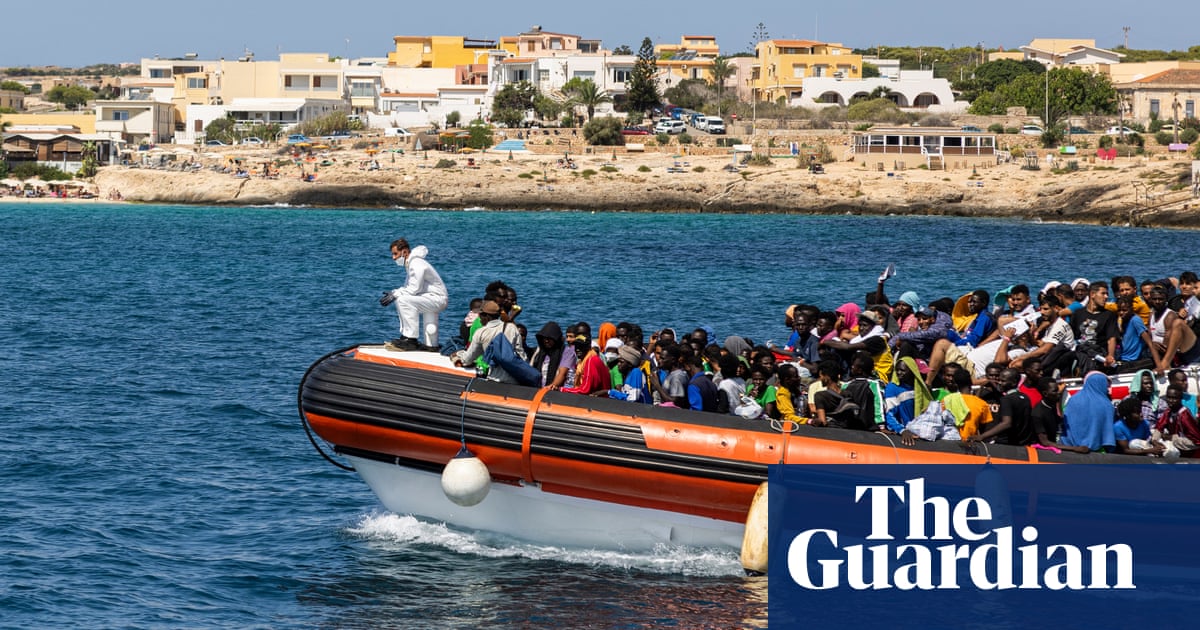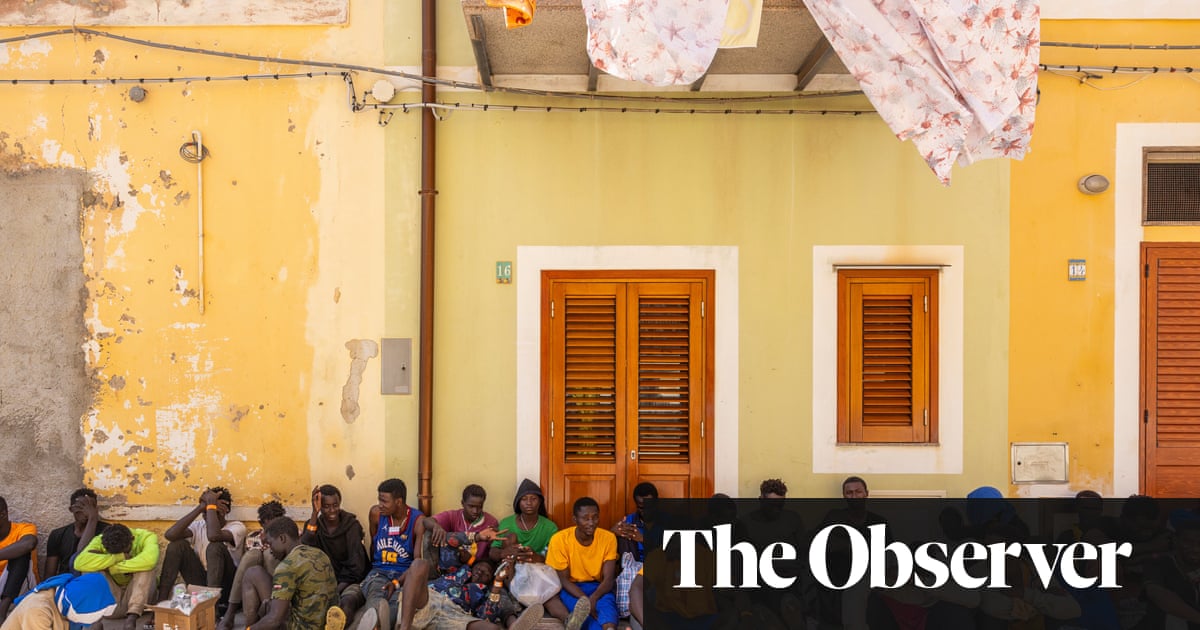
Vito Fiorino and his friends were preparing to go fishing after sleeping the night on his boat docked off Lampedusa when one of them, Alessandro, heard piercing screams. It was about 6am on 3 October 2013. The group often ventured out to sea on the abandoned boat that Fiorino had brought back to life after moving to the tiny Sicilian island a few years earlier. But rarely would they spend the night.
“It was a dark night with lots of stars, no wind and a beautiful sea, and so we decided to sleep on the boat, something we hadn’t done in years,” Fiorino said. “Alessandro got the boat going as dawn broke and after a few metres stopped the engine and asked: ‘Did you hear that noise?’ He used a Sicilian word which means ‘cries of anguish’. There was a huge flock of seagulls so I was convinced that the noise was coming from them.”
Instead of fishing, they sailed further out to sea to explore where the sound was coming from. “After navigating for 800 metres, what I saw in front of me was terrifying,” Fiorino said. “There were about 200 people in the sea, screaming and crying for help.”
Fiorino’s 10-metre boat, called Gama, was the first to arrive on the scene after a flimsy vessel crammed with almost 500 people caught fire and sank not far from the shore of Lampedusa’s famed Rabbit beach.
The bodies of 368 people were recovered in what was one of the Mediterranean’s worst shipwrecks. It was also one of the most shameful episodes for Italy, whose coastguard had ignored repeated SOS calls, and for the EU.
Now, as the 10th anniversary of the tragedy nears, Lampedusa – for years the first port of call for people making the perilous journey by sea from north Africa – and the memories of that night have been thrust back into the spotlight after more than 11,000 people, almost double the island’s population, landed on the island within six days.
Lives have again been lost: on Saturday, the body of a baby who died shortly after being born onboard a boat carrying 40 passengers was placed in a white coffin and taken to the island’s cemetery, where the remains of other people who perished making the journey over the years are buried in unmarked graves. Last week, a five-month-old boy drowned during a rescue operation.
Fiorino and his friends managed to save 47 people in the 2013 shipwreck before the coastguard arrived. When the then prime minister, Enrico Letta, visited the island soon after, he was heckled. There was a similar reaction on Sunday when residents disrupted a convoy transporting the current premier, Giorgia Meloni, and Ursula von der Leyen, the president of the European Commission, to the island’s overcrowded reception centre.
“People are frustrated because in the space of 10 years, nothing has changed,” Fiorino said. “We hear a lot of words, but they are all empty.”
More than 127,000 people have landed on Italian soil so far in 2023 – more than double the number over the same period last year. The majority have set off from Tunisia, where in July Meloni and Von der Leyen signed a controversial £105m deal to stem irregular migration.
Lampedusa, which lies closer to Tunisia than mainland Italy and survives off fishing and tourism, has once again been shouldering most of the burden.
“We will always save lives but we feel abandoned,” said Alfonso Gagliano, a fisher who in April rescued a group of people at sea. “Unfortunately, these frequent arrivals affect us a lot – our livelihoods, healthcare, everything … we just don’t have the services to cope.”
Meloni, who renewed vows to get tough on illegal immigration, said Von der Leyen’s trip to Lampedusa was “a sign of responsibility, not solidarity”. Yet they were spared the scenes of the humanitarian crisis that had played out on the island in the days before their visit.
There had been chaos at the reception centre, which has the capacity to host 400 people, with some sleeping along the rubbish-strewn street that leads up to the facility. Those inside, desperate to find food, tried to climb over a fence. The many who had not got a spot in the centre, which in the past has been criticised for its appalling conditions, bedded down on benches and under trees close to the island’s main thoroughfare, Via Roma.
“Why is it you people think we don’t have a right to refuge or respect?” said Amadou, who was among five young people from the Gambia stranded outside the reception centre on Saturday afternoon. “We are educated, we have studied languages – all we want is a better life.”
By the time Meloni and Von der Leyen arrived the next morning, the majority of people had been transferred off the island to centres in Sicily or mainland Italy, and the area around the reception centre, which the pair toured for about 10 minutes, had been made to look almost pristine.
“They really didn’t see anything of the inhumanity,” said Mariangela Greco, a B&B owner. “Neither do they understand the issues we have to deal with.”
Residents empathise with the arrivals – they have rallied to provide clothing and food, with restaurants offering meals and one elderly woman cooking for people in her home. But they feel that their own problems, including bad roads, poor waste management and a hospital bereft of a maternity unit, are being ignored as they are left to deal with a phenomenon that is showing no sign of subsiding. People continue to arrive – more than 700 since Monday.
Greco was among the residents protesting over fears that the island will be transformed into a so-called “tent city”, even more so after Meloni’s far-right government approved a measure on Monday night giving power to authorities to detain those turned down for asylum in reception centres for as long as 18 months.
“We believe they want to provide tents for 3,000 people – we will not allow it,” Greco said. “The island is too small for something so big and will ruin everything – we survive off tourism and fishing, but mostly tourism.”
After the 2013 disaster, there were fears that tourists would stop coming. Instead, visitor numbers have increased, with new hotels springing up in recent years and more flights to the island.
Beaches remained packed in recent days. “I felt guilty eating while seeing people who were hungry,” said Elena Previtali, who was enjoying the late afternoon sun on a beach metres away from a port where people continued to arrive. “It is a desperate situation that is badly managed.”
With the devastating floods in Libya and earthquake in Morocco, there will be “another wave of desperate people coming to Europe,” said her husband, Alessio.
“There is no magic wand to resolve the situation,” he said. “Either way, it involves Europe, not just Italy.”












